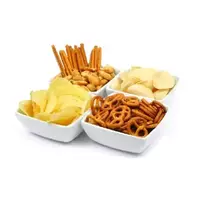Snacks

The snack snack received its original name thanks to the English word snack, which literally means "snack. " In European countries, as well as in the USA and Canada, snacks are called various types of food, which are classified as light snacks or culinary products that can quickly satisfy hunger. It is noteworthy that the inhabitants of our latitudes, as well as the English-speaking part of the planet Earth, have long been familiar with snacks.
In the nearest grocery store you can find various types of snacks. Among the most popular types of snacks, the following can be distinguished:
crackers;
crackers;
corn sticks;
popcorn;
chocolate bars;
breadsticks, both sweet and salty;
nuts;
candy;
chips;
fruit snacks;
dried fruit;
cookies;
jerky fish.
In addition, flour snacks (crumbs or straws), sea snacks (fish, squid), as well as natural snacks (fruits, seeds, nuts) are distinguished. Snacks refer to foods that are designed for a sufficiently long shelf life. In addition, snacks are instant foods and foods. The whole essence of snacks is that this type of food can quickly and without time spent on cooking saturate the human body.
Snacks are primarily a snack, not a full-fledged culinary product. Although in the modern culinary tradition, some types of snacks are used in the preparation of full-fledged dishes. For example, chips have long become a common ingredient in salads, in addition, snack is served at the table with all kinds of sauces or snacks. The same can be said about crackers, crackers, cookies or corn sticks. All of the above snacks on the one hand are considered independent food products.
With competent design and addition, some types of snacks can turn into a real culinary masterpiece in a matter of seconds from a five-minute product for a quick snack. In accordance with the terminology adopted in the food industry, the following components of any snacks can be distinguished:
the snack base may be sweet, salty, or fresh;
the "attractive" component of the snack, as a rule, is chocolate, confectionery sprinkles, nuts and other flavors;
preservatives, i. e. chemical compounds that affect the appearance, taste, shape, as well as shelf life and sale of snacks.
It is worth noting that snacks are often called nothing more than "junk-food, " which literally means "junk food. " Nutritionists call snacks foods that contain empty calories. This means that snacks, as a rule, are not particularly nutritious or beneficial for the human body. However, there are not only harmful, but also certainly useful natural snacks. For example, dried fruits, candied fruits, nuts or snacks made on the basis of cereals, for example, granola.
snacks 143.9 kCal
Energy value of snacks (Ratio of proteins, fats, carbohydrates - ju):
Proteins: 21.8 g (~ 87 kCal)
Fats: 6.3 g (~ 57 kCal)
Carbohydrates: 0 g (~ 0 kCal)
Energy ratio (b | y): 61% | 39% | 0%
 Español
Español Français
Français Português
Português Русский
Русский 简体中文
简体中文 繁體中文
繁體中文 日本語
日本語 한국어
한국어 العربية
العربية Türkçe
Türkçe Қазақ
Қазақ Deutsch
Deutsch Italiano
Italiano Українська
Українська
